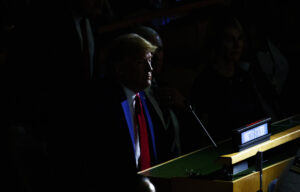No Post-Conflict Decontamination Obligations Set Before UN First Committee Vote

VADIM GHIRDA/AP

NEW YORK—The U.N. General Assembly’s upcoming vote on a resolution to address the effects and use of depleted uranium weaponry is its first since the U.S. military reversed earlier denials and confirmed that it used the radioactive armament late in 2015.
The current draft resolution proposed by Indonesia calls for recognizing the importance of implementing recommended measures to contain the material’s contamination to “mitigate potential hazards to human beings and the environment.” Doug Weir, researcher and policy director for the Conflict and Environment Observatory, hopes that passing the resolution might bolster efforts to mandate greater obligations for post-conflict decontamination efforts. However, legal adviser to the Coalition to Ban Uranium Weapons, Dr. Manfred Mohr, doubts the U.N. committee will have sufficient momentum to enact clean-up measures. Experts agree that such measures must include greater transparency of the weapon’s firing location and assistance in the clearance and containment of the toxic material.
“I do not think the United States will acknowledge the contamination effects of depleted uranium,” Mohr said. “That will make it very difficult for the U.N. to do anything.”
Until its airstrikes against oil tankers in the Islamic State-occupied areas of Syria, the United States had not deployed the armament since the 2003 invasion of Iraq. At that time, its rampant use spurred condemnation from local communities that alleged the toxic material had caused cancer and birth defects.
Initially, the United States denied the toxic deployment in Syria with a statement in March 2015 from John Moore, the spokesman for the U.S.-led anti-ISIS coalition in Iraq and Syria. Moore said flatly that the “U.S. and coalition aircraft have not been and will not be using depleted uranium munitions in Iraq or Syria during Operation Inherent Resolve.”
Eight months later—in November of 2015—Air Force A-10 fixed-wing aircraft shot 5,265 armor-piercing 30 mm rounds containing depleted uranium in Syria. The action was not confirmed until two years later, when U.S. Central Command spokesman Maj. Josh Jacques confirmed it in statements to Airwars and Foreign Policy.
In 2016, the year before the United States formally disclosed that it had deployed the armament in Syria, the U.N. General Assembly addressed the question of depleted uranium’s use and effects. The General Assembly passed a resolution by a vote of 151 to 4—with 28 abstentions—that acknowledged the material’s possible negative health effects and potential for environmental harm. The four states in opposition— the United States, Britain, France, and Israel—argued that there was insufficient evidence that depleted uranium caused harmful radiological exposure to people or the environment.
A 2017 report from the U.S. Armed Forces Radiobiology Research Institute, however, suggested that previous cancer risks assessments from depleted uranium exposure may have been underestimated. In the Journal of Neurotoxicology, a further peer-reviewed study on exposure to the material indicated possible neurological disorders affecting brain development in utero and during breastfeeding. A 2018 statement by the International Atomic Energy Association clarifies that while residues of the material dispersed in soils or waters do not appear to pose a hazard, fragments of the ammunition or scrap metal such as those from targeted vehicles do remain toxic both chemically and radiologically to the environment and to public health.
Ahead of this year’s General Assembly resolution vote, no clear international protocol exists for the clearance or management of post-conflict contamination. “There are no international legal obligations on the United States to address the contamination caused by military use of depleted uranium,” Weir said.
Despite the U.S., U.K., and French opposition to the 2016 U.N. resolution, Mohr said that all three countries have tacitly acknowledged the unacceptability of the material through changes to their military procurement programs and have moved towards less harmful alternatives. States such as Germany, which concluded that depleted uranium was unacceptable in the 1970s, simply abstained from the vote.
“The hypocrisy is depressing,” Weir said, “and it is acting as barrier to measures to clarify and develop post-conflict clearance obligations.”
While the U.S. military insists on its right to use depleted uranium weaponry despite international ethical concerns, legal advice in a 1975 memo from the International Law Division of the United States Air Force did recommend restrictions on how the weapons were used. “Use of this munition solely against personnel is prohibited if alternative weapons are available,” the six-page memo said. Citing legal reasons “related to the prohibitions against unnecessary suffering and poison,” the memo also pointed out the “disproportionate injury to civilians or damage to civilian objects” that could occur from depleted uranium use and that “precautions to avoid or minimize such risks shall be taken in the use of this weapon or alternate available weapons should be used.”
A statement to the U.N. General Assembly from the International Atomic Energy Association this past June said that the risk to the health and safety of exposed conflict areas could be mitigated with “such simple countermeasures as the collection, storage and disposal of such fragments.”
Yet the technical and financial burdens remain challenging for affected states. “Depleted uranium management is complex,” Weir said, “and states recovering from conflict face a number of competing environmental priorities with often very little capacity. You also have a number of practical issues. For example, what does a post-conflict state do with contaminated metal when they may not have a functioning radioactive waste repository?”
The same PAX report estimates that during the 2003 strikes in Iraq alone, depleted uranium contaminated more than 300 sites. To dispose of its properly would cost at least $30 million.
There are other issues beyond the cost burden. Lack of transparency about depleted uranium firing coordinates further frustrates efforts to clean up contamination. Despite earlier requests by the United Nations Environment Program and the Iraqi government for the coordinates that showed where US jets and tanks fired nearly 10,000 rounds in Iraq in 2003, it took the United States until 2014 to produce the information. “Users have historically been very reluctant to release data,” Mohr said.
PAX estimates that more than 300,000 depleted uranium rounds total were fired during the Iraq war, the vast majority by US forces. A small fraction were from U.K. tanks, the coordinates for which were provided to the U.N. Environment Program. A further 782,414 rounds from U.S. forces were believed to have been fired during the earlier conflict in 1991.
The bulk of the firing coordinates remain unknown, including the exact location of the 2015 depleted uranium firing in Syria.
However, increasing international concern over the pollution legacy of armed conflicts may bolster efforts to standardize laws surrounding depleted uranium clean-up. A 2017 U.N. Environment Assembly resolution specifically stressed the need for the swift identification, assessment, and remediation of conflict pollution. In 2016, the U.N. Human Rights Council’s Special Rapporteur on Human Rights and Hazardous Substances and Wastes called for “an effective remedy for hazardous remnants of conflict and other military activities, including funding for full remediation, comprehensive medical treatment and compensation for individuals experiencing the effects of exposure to these materials.”
Dr. Cymie Payne, an international legal scholar and professor of ecology at Rutgers University, said that obligations for post-conflict management of explosive remnants of war are well established and could inform the development of protocol for other toxic damages such as depleted uranium. As an example of how the U.N. system could impose legal obligations for an effective response to depleted uranium contamination, she pointed to the United Nations Mine Action Service, which aims to ensure a coordinated response to the problems of explosive remnants of war.
Should member states acknowledge recent outcomes from the U.N. Environmental Assembly and the Human Rights Commission, measures could be taken to improve transparency of weapon use, provide technical and financial assistance for the assessment and clearance of contaminated areas, and mandate compensations for victim health assistance and exposure monitoring. Weir glimpses an opening for action. “It’s certainly possible,” he said, “given sufficient political will.”
As to the formal statements already submitted for this year’s General Assembly debate, Weir cautions that they do not equate to legal action. “In the past, states such as the U.K. have acknowledged a ‘moral obligation’ to help,” he said, “but that falls far short of what is required.”
Hannah Beckler is journalist based in New York City and is currently pursuing a M.A. degree in Journalism and European & Mediterranean Studies at New York University. Follow her on twitter: @hannah_beckler




